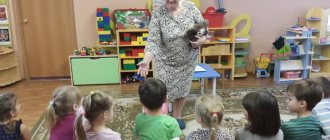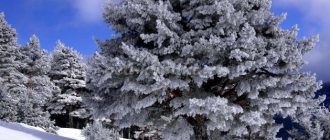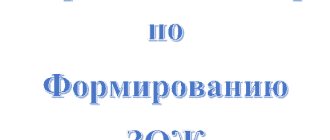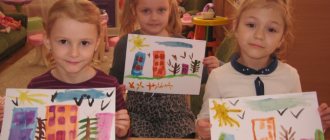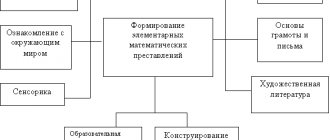Summary of educational activities in the secondary group “Forest Mathematics”.
Summary of educational activities in the middle group
"Forest Mathematics".
Dominant educational area: cognitive development.
Type of children's activities: cognitive - research activities, communicative, gaming.
Methods and techniques for implementing the lesson content:
Verbal:
- artistic expression: nursery rhymes, poems.
- a leading question: how many trees are there in the clearing! Guys, do you know what they are called? (Children's answers).
- problematic situation: mushrooms for the squirrel.
— verbal instruction: find a similar geometric figure.
Visual:
-examination of illustrations and natural material: cards with images of animals and mushrooms, natural material – pine cone.
Practical:
— finger gymnastics “Pine Cone’s Journey”
— didactic exercise: “Wonderful bag”
- productive activity (sculpting): “Mushroom for a squirrel”
Integration of educational areas: “Physical development”, “Social and communicative development” , “Artistic and aesthetic development”, “Speech development”.
Goal: To form mathematical concepts and sensory standards in children.
Tasks:
1) Teach quantitative counting up to 5.
2) Learn to compare objects by length and height.
3) Learn to denote in words the position of an object in relation to oneself.
4) Develop the ability to distinguish and name geometric shapes: triangle, circle and square.
5) Cultivate a friendly attitude towards animals and a desire to help them.
Organization of a developmental environment for conducting classes (educational activities)
The group contains models of a forest clearing (trees, paths with animal tracks, a carpet clearing, wonderful bags with geometric shapes, a basket with pine cones); train layout from geometric shapes (triangle, square, circle, oval); toys (bear, fox, squirrel); handouts for work (plasticine and boards) are placed on the tables; installed screen, computer, magnetic board; organization of musical accompaniment; pictures with images (animals, train, cones, mushrooms of different sizes).
OD progress
Educator : Good morning, guys!
Children: Good morning!
Educator: What a wonderful day today is for a walk, and I suggest you go to the forest! Want to?
Children: Yes!
Educator: But the forest is far away. What transport can you use? (Children's answers). I suggest taking a ride on the magical geometric train.
Educator: Look at what geometric shapes the train cars are made of (triangle, circle, square, oval). But in order to travel on the magic train, you need to get tickets and then take a seat according to the ticket. (Hand out tickets. Tickets correspond to a carriage with a certain geometric figure.) Look carefully at your tickets. What do they show? (Children's answers) You need to sit in the carriage that depicts the same figure as the one on your ticket. (Questions for children: why did you get into a carriage with a triangle, a circle, a square?) Raise your tickets, I’ll see if everyone found their carriage correctly? Let's go to the forest! (Music sounds).
Steam locomotive, steam locomotive - shiny new
He drove the trailers as if they were real,
Triangle, circle, square
Locomotive take the guys!
(A clearing is depicted in which there are many trees, the sounds of nature are heard. In the forest clearing (carpet) there are models of trees and paths depicting animal tracks)
Educator: Well, here we are in the forest. Look what trees grow in the forest? (Children's answers). How many Christmas trees? How many birches? Which tree is the tallest? What kind of Christmas trees? (low). What animals can live in the forest? How can you call them in one word? (Wild). They left their footprints on the paths. How many paths? Show me the longest path? Who do you think left their traces on it? (Bear). Show me the shortest path? Well done! I suggest following the bear's tracks. (The children, together with the teacher, follow the tracks of the animal.)
Nursery rhyme:
A clubfooted bear walks through the forest
(Imitate the habits of an animal)
Collects cones and sings songs!
Educator: Hello Mishka. Today you are the first person we met in the forest, why are you so sad?
Guys, Mishka told me that he collected pine cones in the forest, but he doesn’t know how to count. Shall we help him?
Children: Yes! (The teacher takes one cone out of the basket and puts it on the table, the children keep count - 1,2,3,4,5). Guys, how many cones did Mishka collect? (five). Mishka says thank you for helping him. Goodbye Mishka! And we will continue our walk through the forest.
Which path should we take next? (short, with fox tracks). (Children walk on their toes in the footsteps of the fox.)
Nursery rhyme:
You are a fox - don't be angry
Better make friends with us!
They meet a fox sitting behind a tree. Hello Foxy! Guys, where is the fox sitting (behind the tree, in front, to the left, to the right of the tree)? Why are you sad? (Fox: no one plays with me, play with me).
Game "Wonderful bag"
“Error method”: the fox takes out a figure and names it incorrectly, the children give the correct answers. Children put their hand into the bag, describe the geometric figure, name it and take it out). What geometric figure did you get? Why is it called a triangle? Etc. The fox thanks the children, the children and the teacher continue their walk through the forest.
Educator: Now let's go along which path? (According to the shortest one). They are following the tracks of a squirrel.
Nursery rhyme:
The squirrel is jumping, jumping, jumping,
And I found a fungus in the forest!
Educator: Why are you crying squirrel? Come to us and tell us. (Squirrel whispers to the teacher). Guys, the squirrel says that she didn’t have time to stock up on mushrooms for the winter, should we help her?
Children: Yes!
Invitation to the clearing.
Educator: But, from the beginning, I suggest you relax in the clearing. Finger gymnastics “Journey of the cone”
(After finger gymnastics, the teacher invites the children to sit at the tables for practical activities)
Modeling “Mushrooms for Squirrel”
Children give mushrooms to Squirrel. Squirrel thanks the children and says goodbye.
Educator: It's time to go back to kindergarten.
(The children, together with the teacher, return to kindergarten by train).
Educator: Our journey has ended. What did you like most? What was the most difficult wild animal task? You guys did everything right and completed all the tasks. Well done! Next time we will go on another interesting journey.
Summary of an open lesson on speech development in the middle group “Once upon a time there were fairy tales”
And she planted the seed of kindness.
Supporting diagrams for classes on speech development for children speech development
Fairy tale "The Ryaba Hen"
Fairy tale "Three Bears"
Self-analysis of an open lesson on speech development
in the middle group “Once upon a time there were fairy tales.”
Dear Colleagues! We present to your attention classes on speech development in the middle group “Once upon a time there were fairy tales.”
Goal: to develop children’s cognitive and speech skills using their favorite fairy tales as an example.
When developing the outline, I took into account the program requirements and age characteristics of children in the middle group.
To achieve this goal, I set the following tasks:
— To consolidate children’s knowledge about Russian folk tales.
— Continue to develop coherent speech, correctly coordinate words in a sentence.
— Develop attention, memory, logical thinking, creative imagination.
— Enrich children’s vocabulary with words: “fidgety,” “minx,” “lazy,” “fluffy,” “nimble,” etc.
— Cultivate interest in Russian folk tales
Preliminary work:
1. Look at illustrations for fairy tales.
2. Making riddles about fairy tales.
4. Showing the fairy tale “The Three Bears” (On a magnetic board).
This lesson was developed taking into account modern requirements (FSES DO, SanPin)
. The duration of the NOD corresponded to hygienic standards for children of this age. Frequent changes of activities throughout the activity allowed the children to avoid fatigue.
In its structure, direct educational activities are built on a single game plot in order to arouse and maintain the cognitive interest of children. Consists of 3 interconnected parts: introductory, main and final.
The water part of the educational activity itself involved organizing children: creating an emotional mood, setting for the upcoming activity, switching attention to the upcoming activity, stimulating interest in it. It was done with a greeting, a surprise moment.
The main part of ECD is aimed at independent mental and practical activity, fulfilling all assigned tasks.
The main part of the GCD included tasks for repeating the studied material (composing fairy tales according to diagrams; here I tried to get complete, clear answers from the children to the questions asked. The children actively answered).
A magnetic board was used to compose the tale “The Three Bears”. Here the children independently composed a fairy tale based on cut and mixed up pictures.
In the final part, summing up the lesson, I involved the children in this and asked them to speak on the topic: What did you like most about the lesson?
Summary of an open lesson in the middle group
Summary of an open lesson in the middle group on the topic “Journey to the forest.
Drawing according to the model" Author:
Pushkina Natalya Aleksandrovna, teacher of the MDOU compensatory kindergarten No. 60, Yaroslavl.
Description of the material:
I offer you a summary of an open integrated lesson for children 4 - 5 years old, including elements of ecology, cognition, and drawing.
This material will be useful for middle school teachers. Summary of a lesson in the middle group on the topic “Journey to the forest. Drawing from a model." Types of children's activities:
gaming, communicative, productive, cognitive-research, perception of fiction.
Goal: expand children’s understanding of the forest, improve drawing skills. Objectives: consolidate knowledge about trees; cultivate a desire to respect nature in everyday life; promote the development of thinking, cognitive interest, imagination; learn to draw a tree in an unconventional way. Preliminary work with children:
learning poems and riddles with children.
Decoration of the group: landscapes by I.I. Shishkin. “Coniferous forest”, “Spruce forest”, “Birch grove”, “Forest edge”, “Oak”; poster-drawing of environmental situations; artificial Christmas trees. I Organizational moment. Educator:
Guys, we received a telegram
(showing, reading)
“I love you very much, friends, Come visit, I’m waiting.
Forest" The forest invites us to visit! But the one who answers the questions ends up in the forest. — What time of year is it now? What month? — What month was before October? — What will it be like after October? - Name all the autumn months. (children's answers) Educator:
Autumn flew by and scattered the leaves.
To get into the forest, you need to turn into leaves. Take one leaf at a time (children choose any leaf of the tree)
One, two, turn around - and turn into a leaf
(children complete the task)
- What tree did you grow up on?
Children's answers (I grew up on a birch tree)
- So what kind of leaf are you?
(birch leaf)
, etc. - The wind blew and the leaves flew.
(Music sounds. Disc “Smile” T-53)
- We flew into a clearing in the forest.
II Guessing riddles. Educator:
Hello forest, dense forest, full of fairy tales and miracles. What are you making noise about with the leaves?... Open everything, don’t hide it.
You see we are ours. - Guys, what is a forest? (many trees)
- What trees grow in the forest?
(children's answers)
- What riddles about trees do you know?
Child 1:
Her clothes are pinched - Everything is needles, yes needles Animals joke: “Uncle hedgehog looks a little like her”
(Christmas tree) Child 2:
I have longer needles than the Christmas tree Very straight I grow in height If I’m not at the edge Only branches on the top
(pine)
- What kind of trees are spruce and pine?
(conifers) Child 3:
Sticky buds Green leaves With white bark Stands above the mountain.
(birch) Child 4:
What kind of tree is there? There is no wind, but the leaf is trembling.
(aspen) Child 5:
The Bee takes the most delicious honey from my flower.
And everyone offends me. They peel off the thin skin. (linden) Educator:
they used to peel the bast bark from the bark of young linden trees, and weave bast shoes from it.
(show bast shoes) III Ecological situation Educator:
Many poems have been written about the forest, many pictures have been drawn.
- Why does a person love the forest so much? (children's answers)
- What poems do you know?
Child 6:
The oak tree is not afraid of rain and wind.
Who said that oak is afraid of catching a cold? After all, until late autumn I remain green. That means I'm resilient. So, hardened. Child 7:
Near the river near the cliff The willow is crying, the willow is crying Maybe she feels sorry for someone?
Maybe she's hot in the sun? Maybe a playful wind pulled the willow by its pigtail? Maybe the willow is thirsty? Should we go ask? Educator:
Look carefully at this drawing, it really hurts me to look at all this.
— What can’t you do in the forest? (children’s answers based on the picture)
- Why can’t you break branches?
(living trees)
- Why can’t you destroy nests?
(birds are our friends, we help birds)
- Why can’t you throw away garbage?
(The forest is a home for plants, animals, birds. The house must be clean.) IV Environmental training. Educator:
Now we’ll play, imagine yourself as trees...
(children closed their eyes)
What kind of tree are you?
And you? (children's answers: I am a birch tree, I am an oak tree, I am a rowan tree, etc.)
My roots are deeply rooted in the ground.
My trunk, my branches reach towards the sun. These are trees in the forest. (open our eyes)
We wave our hands smoothly.
These are the birds flying towards us. We'll show you how they sit down. The wings are folded back. Now we will walk quietly, sit at the tables and draw trees. V Drawing See what trees you can draw. (Sample showing) Stage 1 – Take a sheet of white paper and apply paint in the center on one half with strokes. Take warm colors: red, yellow, green. Stage 2 – Fold the sheet and stroke it. Stage 3 – using the magic spell “Pona - Mona - Kona” we open the leaf, it turns out - a crown. Draw the trunk and branches. — What did the tree hide from people? (roots)
What beautiful trees you have turned out to be!
Tell me please, what tree did you draw? (interview the guys) VI Reflection - Where have we been? (visiting the forest)
What did you do?
(played: turned into leaves, into trees, were in a clearing, looked at pictures, etc., drew)
Did you enjoy your visit? Will you take care of Him? The forest gives you a treat...
We recommend watching:
GCD summary in the middle group “Visiting the Traffic Light” GCD summary in the middle group on the theme “New Year” GCD of an educational nature in the middle group “Timoshka and the famous artist” GCD summary for FEMP in the middle group
Similar articles:
Summary of continuous direct educational activities in the middle group
Summary of GCD in the senior group on the topic “So that your teeth don’t hurt”
Summary of GCD in the middle group on the topic “Journey to the autumn forest”
Summary of GCD in the middle group on the topic: “So summer is over”
